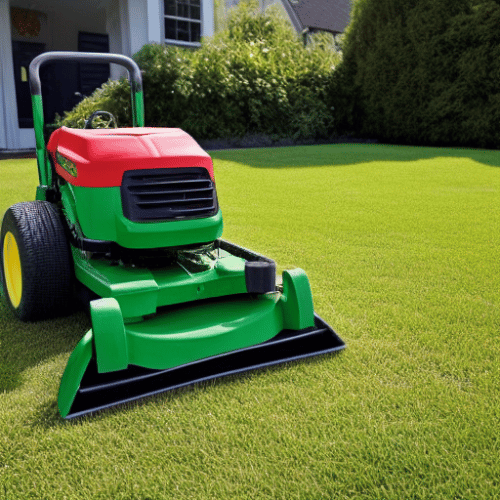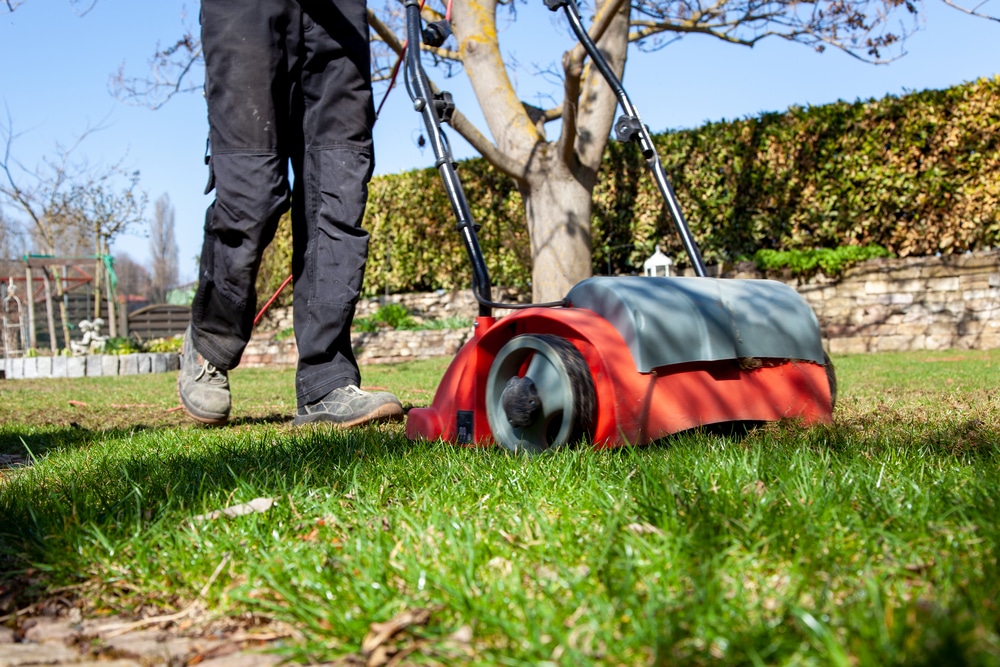Last Updated on
Using a lawn scarifier can greatly help the quality and health of your garden. Scarifying a lawn can also help remove moss and debris so that your grass can flourish and grow properly. But when is the best time to use a scarifier? When will this tool have the best effect and help keep a healthy lawn? We discuss this in the below article!
What is a Lawn Scarifier?
On the first inspection, a scarifier may look like a lawnmower. Indeed these tools look incredibly similar to mowers in their shape and design. They serve a different function, though.
Function

Scarifiers or dethatchers are garden tools that cut through or rake your soil. They do this without damaging the grass. Whilst raking, scarifiers remove debris, dead grass, and dangerous items like moss and thatch.
These tools also help aerate lawns and soil and allow for proper irrigation and drainage. In short, they are a fantastic piece of equipment for lawn maintenance. Using a scarifier and mower, you can easily keep on top of your lawn management and make sure that your grass is healthy.
Design
As mentioned, a scarifier looks like a mower. It has a main chassis that contains scarifying blades. From this, there is a long handle that you use to push the device. Some scarifiers are powered and have an electric motor. Others are manual and work by force. Most scarifiers will also have a collection bin or collection bag to pick up the moss and thatch, and other debris raked from your lawn.
Why Scarifying at the Wrong Time Could be Damaging?
Before we look at specific times, it is important to understand what could go wrong. Why is it important to scarify at the right time and season? Why can’t you just rake your lawn whenever you want?
You need to scarify at the right time. Otherwise, you could damage the health of your grass. For example, if you scarify during cold, harsh weather, your grass may not recover and could die. Scarifying does put a little stress on your lawn. Therefore, you must consider the conditions so that your grass can recover and can grow and flourish after the process.
When to Use a Lawn Scarifier
So when is the ideal time to scarify? You must understand the basics here. Timing is highly important for lawn scarifying. If you get the time wrong, you could damage your grass plants and harm your garden. Fear not – in the below section. We discuss the nuances of scarifying and the best times to do it.
When Your Grass Has Lost Its Lustre
You can often tell when it is time to scarify simply by looking at your grass. This is the first thing to consider. What is the current health status of your grass? Is there a lot of moss that needs to be removed? Is the grass patchy? Are there too many weeds? Maybe the grass has a yellowish tinge and doesn’t look as bright and vibrant as it should?
These are all factors pointing towards scarifying your lawn. However, it’s not a simple case of seeing that your lawn looks tired and immediately scarifying. You must then consider the below factors too.
When Your Grass Has Ideal Moisture and Growth
As mentioned, scarifying your lawn can put stress on your grass. If it does not, it may not properly grow when scarified. Therefore, it is best to scarify your lawn only when the grass has ideal moisture and growth conditions.
The ideal condition is that the grass is dry to touch but has some moisture in the soil underneath. For example, you may have just had a little rain-soaked into the soil, but the surface grass is now dry.
Late Spring
With the right conditions, and the correct circumstance (i.e. you need to remove moss, or your grass is looking tired), two seasons are the best to scarify your lawn. First, late spring is considered one of the best times. During late spring, the weather and ground conditions are ideal.
Temperatures are starting to improve, but there may still be some rainfall to give your grass that much-needed wetness. Springtime is generally considered to be March to May. Therefore, scarifying in May is usually a perfect time.
Early Autumn
Next, we have early autumn. This is again another period where there are no extreme weather conditions. For example, temperatures can be high during the summer, and your grass can be incredibly dry. This does not promote growth. Alternatively, during the winter, temperatures drop, and this can really hamper grass seed growth.
During early autumn, the temperatures are mellowing from the summer, but the conditions are still ideal for scarifying your lawn. Autumn is generally considered to be September, October, and November. Therefore, scarify your lawn in September, and the conditions should again be ideal.
Other Considerations
Before scarifying, for best results, it is also advisable to mow the lawn one week prior. This will prepare your lawn to be scarified. For example, it will remove some of the thatch, weeds, and moss and make the scarifying process easier.
You may want to water your garden before the process too. This will give the soil and grass the water they need to grow after the scarifying. Lastly, never scarify when the grass is wet. If you do, you risk pulling the grass up and damaging your lawn as the wet grass could get stuck to the blades.
When the Timing Is Right
We hope you have found this guide on when to use a lawn scarifier useful. If you want to invest in this machine, you must understand how and when to use it properly. If you scarify your lawn at the incorrect time, you can risk damaging the health of your grass and soil, and it may not recover. As a result, scarifying in the spring and autumn and during ideal weather and ground conditions is the best practice.
Do you schedule scarifying grass? Tell us in the comments below.
Paul is the type of person who never met a problem he couldn’t fix. He can always be found tinkering with something in his house, even if it isn’t broken! His tips and tricks are often shared on our site. He’s the one you call when something breaks because he has been known to improvise fixes for everything from leaky faucets to malfunctioning dryers.



